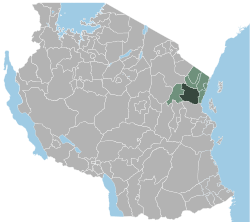Handeni District
| Handeni District Wilaya ya Handeni (Swahili) | |
|---|---|
| District | |
 Location in Tanzania (dark green) | |
| Country | Tanzania |
| Region | Tanga |
| Government | |
| • District Commissioner | Seif Mpembenwe |
| Area | |
| • Total | 7,366.41 km2 (2,844.19 sq mi) |
| Population (2012) | |
| • Total | 355,702 |
| • Density | 48/km2 (130/sq mi) |
| Time zone | EAT (UTC+3) |
| Postcode | 218xx |
| Area code(s) | 027 |
| Website |
tanga |
Handeni is one of the eight districts of Tanga Region in Tanzania. It is bordered to the west by the Kilindi District, to the north by the Korogwe District, to the east by the Pangani District, and to the south by the Pwani Region. It split in 2002 to form the Kilindi District.
According to the 2002 Tanzania National Census, the population of the Handeni District was 248,633.
Wards and villages
The Handeni District is administratively divided into 7 divisions, 19 wards and 112 Villages.
The Government at the District level is led by Retired Lieutenant Winfred Francis Ligubi as District Commissioner since 2006 succeeding Manju Salum Omar Msambya who became a Member of Parliament for Kigoma South in 2005. The Handeni District Council is led by Hon. Jabir Manyendi Kigoda (Chairman), Mr. Xavier Tilweselekwa (Council Director).
The district has a population increase of 4% per year.
The dramatic open area to the North of Handeni at the foot of the Maasai Steppe was the setting for Ernest Hemmingway's classic hunting book, The Green Hills of Africa.
Pongwe
Pogwe is a village within Kang'ata ward in Handeni District. In Pongwe village there is a natural spring water place called Kwekibaya. Kwekibaya is the only source of water for thousands of people and animals from nearby villages: Msaje, Kwaluwala, Kwedinguzu, Kwamagome, Komwale, Kwavulata, etc. The original people from this place are called Wapongwe (Samwepongwe for male and Mnamweponge for women).
Kwekibaya is without its miracle. For example, if a person not belonging to Wapongwe clean the water source (the place where water is actually coming out to the surface), kwekibaya dries out. If such incident happens, it is only wapongwe family member who can please the natural spring to give out water again.
Mzee Mkulago with his wife Khadija Zuberi Mswagilo were blessed to have five children namely: Salima, Shaban, Juma, Abdallah and Sadiki. Juma, was educated at Pongwe Primary School, then Handeni Secondary School, Tanga Secondary School, then received his first bachelor's degree in Computer Science from the University of Dar es Salaam. Juma pursued master's degree and Ph.D degree from the University of Oslo, Norway.
Because of the importance of kwekibaya, there is a chain of family leaders among the wapongwe who guide the community in managing the Kwekibaya in particular and general resources such as deforestation issues (which forest is a reserved one). The last leader of wapongwe is Mkulago (1942–2006). Mkulago died on 28 April 2006 and lied to rest on 30 April 2006 in the Mtonger forest. He was succeeded by his first son, Shaban Mkulago. Other Wapongwe family members who can please the Kwekibaya water spring are Dr. Juma Lungo (Ph.D), Hussein Nguvu, Abdalah Lungo, Sadiki Lungo, and mnamwepngwe Bi. Salma Mkulago (first daughter of Mzee Mkulago).
Sources
- Population of Handeni
- Handeni District Investment Profile 2007: can be sent to you by Email: Contact: [email protected]
Coordinates: 5°30′00″S 38°00′00″E / 5.5000°S 38.0000°E